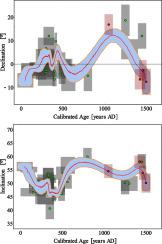Physics of the Earth and Planetary Interiors ( IF 2.4 ) Pub Date : 2021-04-15 , DOI: 10.1016/j.pepi.2021.106709 E. Aidona , S. Spassov , D. Kondopoulou , G.S. Polymeris , K. Raptis , A. Tsanana

|
In the present study we report on archaeomagnetic and luminescence results from three ceramic kilns unearthed in a workshop during the subway (METRO) excavations in Thessaloniki (N. Greece) as well as from a small kiln at Ierissos (Chalkidiki). The first settlement is situated in the western part of the city where several similar workshops were excavated in the past. The archaeological information attributed a possible Ottoman age to these structures and placed their last use after the 14th century CE. The other small kiln is one of the rare “in situ” remains within the settlement reported as “Medieval Ierissos”. A total of fifty-five hand samples were retrieved from the four kilns and studied following established archaeomagnetic protocols in order to define the full vector of the magnetization. Additionally thermoluminescence (TL) experiments have been performed on the same material for the Thessaloniki kilns and the obtained ages converge and refine the archaeological ones. At Ierissos optically stimulated luminescence (OSL) experiments on five samples revealed the firing history of the structure. The combination of archaeological and/or TL-OSL information allowed to define four new full vector recordings for the improvement of the secular variation curves during the second millennium CE where intense variations of the Geomagnetic Field are reported from several places in Europe. The new data, together with recently published ones for the first millennium CE, allow to update the directional reference curves, poorly constrained for this period.
中文翻译:

塞萨洛尼基和哈尔基迪基(希腊北部)的中世纪窑炉上的古磁场和发光:最近两千年来对地磁场变化的影响
在本研究中,我们报告了在塞萨洛尼基(希腊北部)地铁(METRO)开挖期间在车间内出土的三个陶瓷窑以及在伊里索斯(哈尔基迪基)的一个小窑中出土的三个陶瓷窑的古磁和发光结果。第一个定居点位于城市的西部,过去曾在此挖掘过几处类似的作坊。考古资料将可能的奥斯曼帝国时代归因于这些结构,并将其最后一次使用于公元14世纪之后。另一座小窑炉是定居点内据称是“中世纪Ierissos”的稀有“原位”残骸之一。为了确定磁化的完整矢量,从四个窑炉中总共检索了55个手样本,并按照既定的古磁协议进行了研究。此外,在塞萨洛尼基窑的相同材料上进行了热致发光(TL)实验,并且所获得的年龄收敛并完善了考古年代。在Ierissos,对五个样品的光激发发光(OSL)实验揭示了该结构的发射历史。结合考古和/或TL-OSL信息,可以定义四个新的完整矢量记录,以改善第二个千禧年期间的长期变化曲线,据报道欧洲一些地方的地磁场变化剧烈。新数据以及最近发布的关于第一个千年CE的数据,可以更新方向参考曲线,该曲线在此期间的约束较弱。











































 京公网安备 11010802027423号
京公网安备 11010802027423号